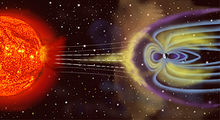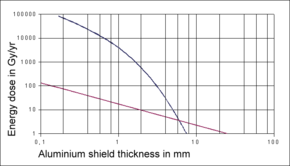Van Allen radiation belt
![]()
This article is about the Earth's radiation belt; for the book by Wolfgang Herrndorf, see This Side of the Van Allen Belt.
The Van Allen radiation belt (named after James Van Allen) is the Earth's radiation belt. It is a ring (torus) of energetic charged particles in space that are trapped by the Earth's magnetic field. The magnetosphere acts as a shield for the Earth because it prevents such lethal particles from reaching the Earth's inhabitants. Other planets are also surrounded by similar belts, but the Van Allen belt refers only to the radiation belt around the Earth.
The belt essentially consists of two radiation zones. The inner one extends at low latitudes, i.e. near the equator, in a range of about 700 to 6,000 kilometres above the Earth's surface and consists mainly of high-energy protons. The outer one is located at an altitude of about 16,000 to 58,000 kilometres and contains mainly electrons.
Until now, it was assumed that the particles of the Van Allen belt originate mainly from the solar wind and cosmic radiation. However, recent investigations of the results of the probes "Van Allen A" and "Van Allen B" show that a large part of the particles originates in the belt itself, where atoms are virtually torn apart by electromagnetic fields and electrons are thus released.
The charged cosmic particles are deflected in the Van Allen belt by the Earth's magnetic field due to the Lorentz force, enclosed in a magnetic bottle and thus oscillate back and forth between the poles of the Earth with an oscillation period of about one second.
When the belt is supercharged, the particles graze the Earth's upper atmosphere and excite it to fluoresce, creating the aurora.

Van Allen Radiation Belt

The magnetosphere shields the Earth's surface from the charged particles of the solar wind.
Detection
The presence of a radiation belt has been suspected since before the Space Age. The theory was confirmed on January 31, 1958, by the Explorer 1 mission and by the follow-up Explorer 3 mission, led by James Van Allen. Further Explorer missions were able to map the particles.
The graph illustrates the distribution of particle density around the Earth. High-energy protons (top image) are concentrated in the inner radiation belt above 3,000 and 6,000 km above the Earth's surface. High-energy electrons (bottom) reinforce the inner one and form the outer radiation belt around 25,000 km altitude. The particle density of protons with energy greater than 10 MeV and electrons with energy greater than 0.5 MeV is of the order of 106 particles/(cm²-s). The ionization radiation load by electrons on electrical components is 0.1 to 1 krad/h (1 to 10 Gy/h), by protons (behind 1 cm aluminum shielding) two orders of magnitude lower.
As part of the Pamela experiment, it was demonstrated in 2011 that an accumulation of antimatter exists in the inner radiation belt of the magnetosphere. The detected antiprotons are presumably produced by the collision of high-energy cosmic rays with the Earth's atmosphere.
In September 2012, the Van Allen probes were able to detect a third radiation belt, clearly separated from the outer Van Allen belt by a gap, in addition to the two known radiation belts on Earth. After being measurable at a constant intensity for about a month, the temporary radiation belt was dissipated by a powerful solar flare. NASA researchers suspect that such temporary radiation belts are more common.
_1964,_MiNr_1083.jpg)
GDR special stamp "Exploration of the radiation belts" from 1964

Radiation belt (top: protons, bottom: electrons)
Radiation exposure
See also: Radiation exposure
The equivalent dose of the radiation of both main zones behind 3 mm thick aluminium is under extreme circumstances up to 200 mSv/h (millisievert per hour) in the core area of the inner belt and up to 50 mSv/h in the core area of the outer belt. Normal values in the whole Van Allen belt are 0.7-1.5 mSv per day (effective dose). This discrepancy can be explained on the one hand by the different measuring methods, on the other hand by the dependence of the radiation on the strong fluctuations of the solar activity. As a result, values 1000 times higher can sometimes be measured. On Earth, the radiation of the inner Van Allen belt can be clearly observed in the area of the South Atlantic Anomaly.
For comparison, in Europe the mean radiation dose at sea level is about 2 mSv/a ≈ 0.2 µSv/h.

Absorbed dose at an altitude of about 38,000 km, behind an aluminum shield of variable thicknessBlue : electrons, red: bremsstrahlung (double-logarithmic representation)
Questions and Answers
Q: What is a Van Allen radiation belt?
A: A Van Allen radiation belt is a zone of charged particles that come from the Sun as the solar wind and are captured and held by the Earth's magnetic field.
Q: How many Van Allen radiation belts does the Earth have?
A: Earth has two Van Allen radiation belts and sometimes others.
Q: Who discovered the Van Allen radiation belts?
A: The belts were discovered by James Van Allen.
Q: How far do Earth's two main belts extend?
A: Earth's two main belts extend from the altitude of about 500 to 58,000 km (310 to 36,040 mi).
Q: Where are the Van Allen radiation belts located?
A: The belts are in the inner region of Earth's magnetosphere.
Q: What do the Van Allen radiation belts trap?
A: The belts trap energetic electrons and protons.
Q: Why do satellites need adequate shielding if they spend time in the Van Allen radiation belt?
A: Satellites need adequate shielding if they spend time in the Van Allen radiation belt because the belts endanger satellites, and their sensitive components need to be protected from the energetic particles trapped in the belts.
Search within the encyclopedia